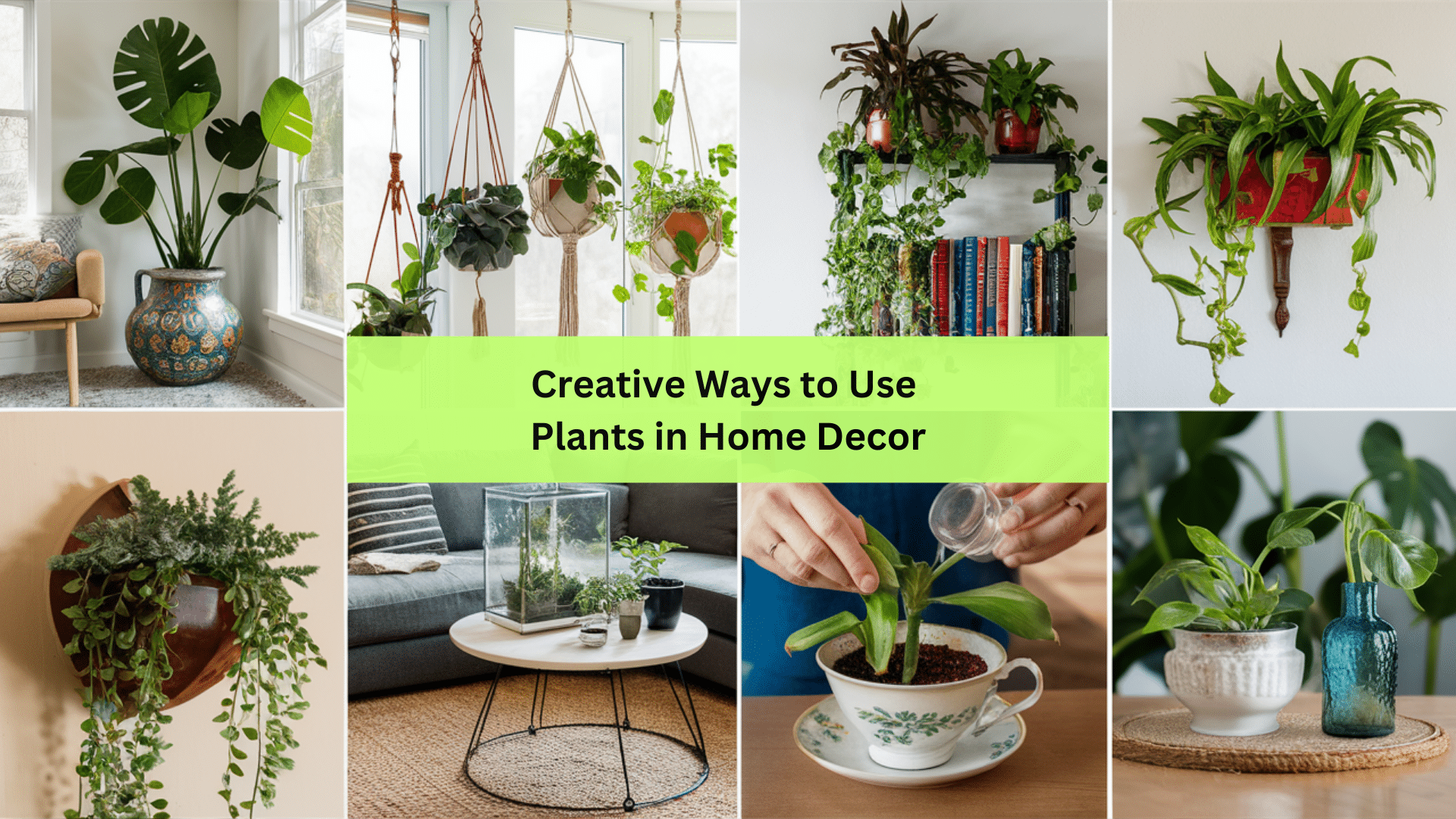Have you been staring at those plain, boring spots in your home that need a touch of life? I was in the same spot last year.
Adding plants to your home is easier than you think. With some basic supplies and a little patience, you can make any room feel fresh and welcoming without spending a fortune on expensive decor.
In this guide, I’ll walk you through:
- Simple ways to use plants in your home
- Finishing Touches and Care Tips
- Common mistakes and how to avoid them
Many people worry about killing plants or not knowing where to put them. I had those same concerns! But after trying different methods, I found simple approaches that work well.
You don’t need to be a gardening expert. My guide breaks everything down into small, manageable ideas that anyone can follow.
Trust me – if I could turn my dull living room into a green, lively space, you can too.
Creative Ways to Use Plants
Now for the fun part – actually decorating with plants! After all that planning, you’re finally ready to see your vision take shape.
1. Hanging Planters
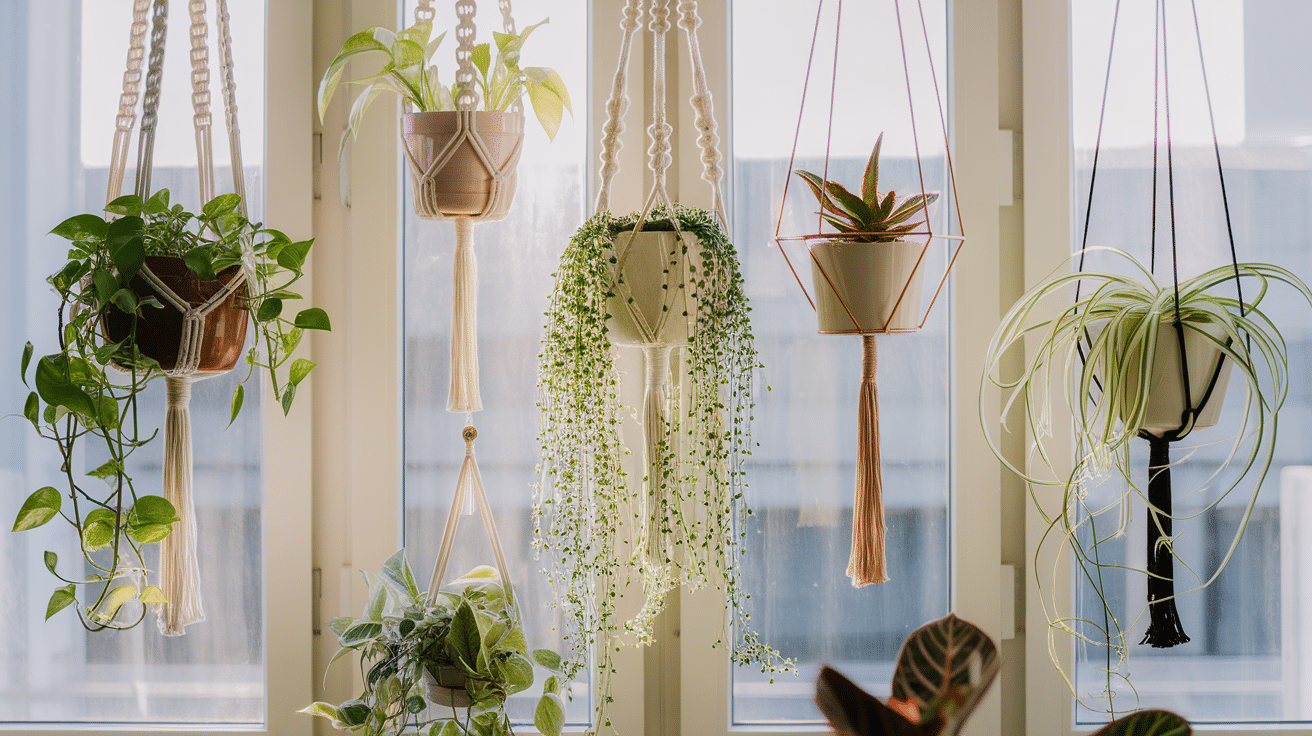
Windows provide perfect light for plants but often have limited surface space. Hanging planters solve this problem beautifully by using vertical space instead.
- Try macramé holders for a soft, textured look that adds warmth
- Use adjustable hanging systems that let you raise or lower plants as needed
- Mix plant types that trail downward with those that grow upward
2. Window Shelves
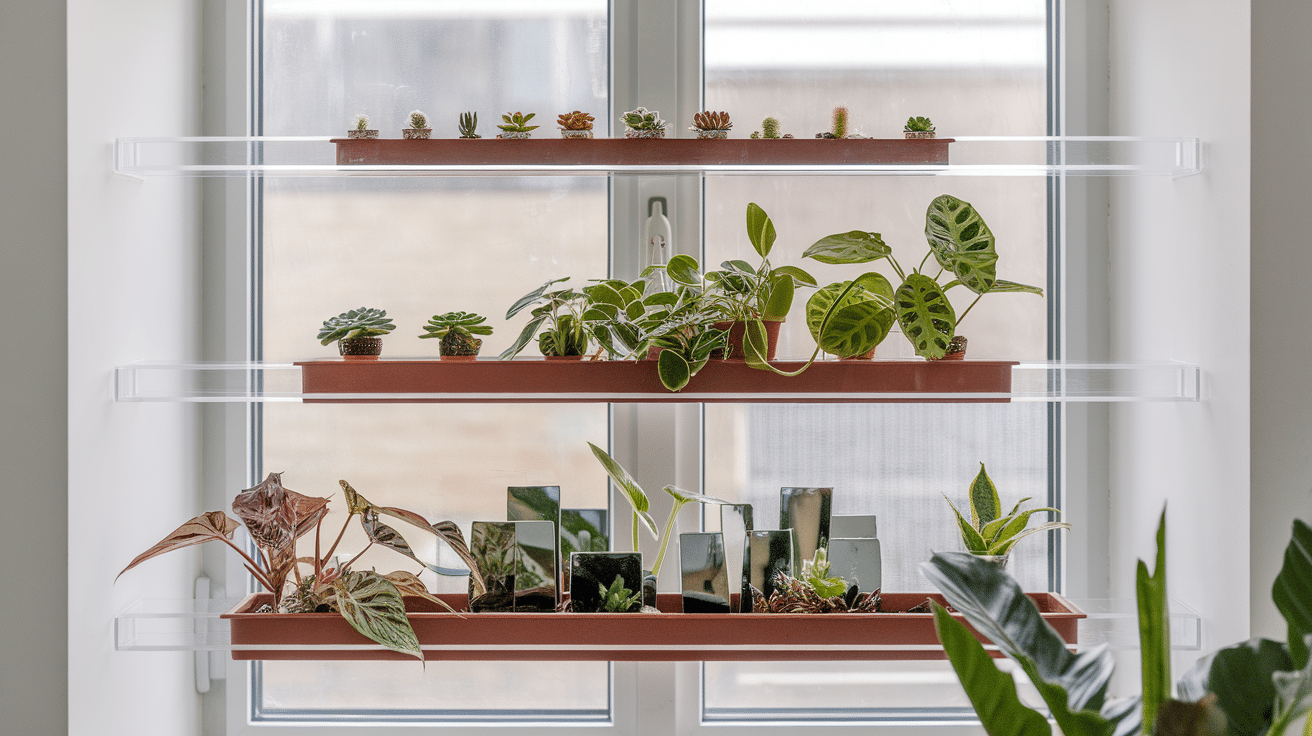
Adding thin, unobtrusive shelves across windows creates perfect plant platforms without blocking significant light. This approach works especially well for collectors with many small plants.
- Install clear acrylic shelves for a nearly invisible support system
- Arrange plants in ascending height order to maximize light exposure
- Use tension rods for a no-drill option in rental homes
3. Sunny Sill Arrangements
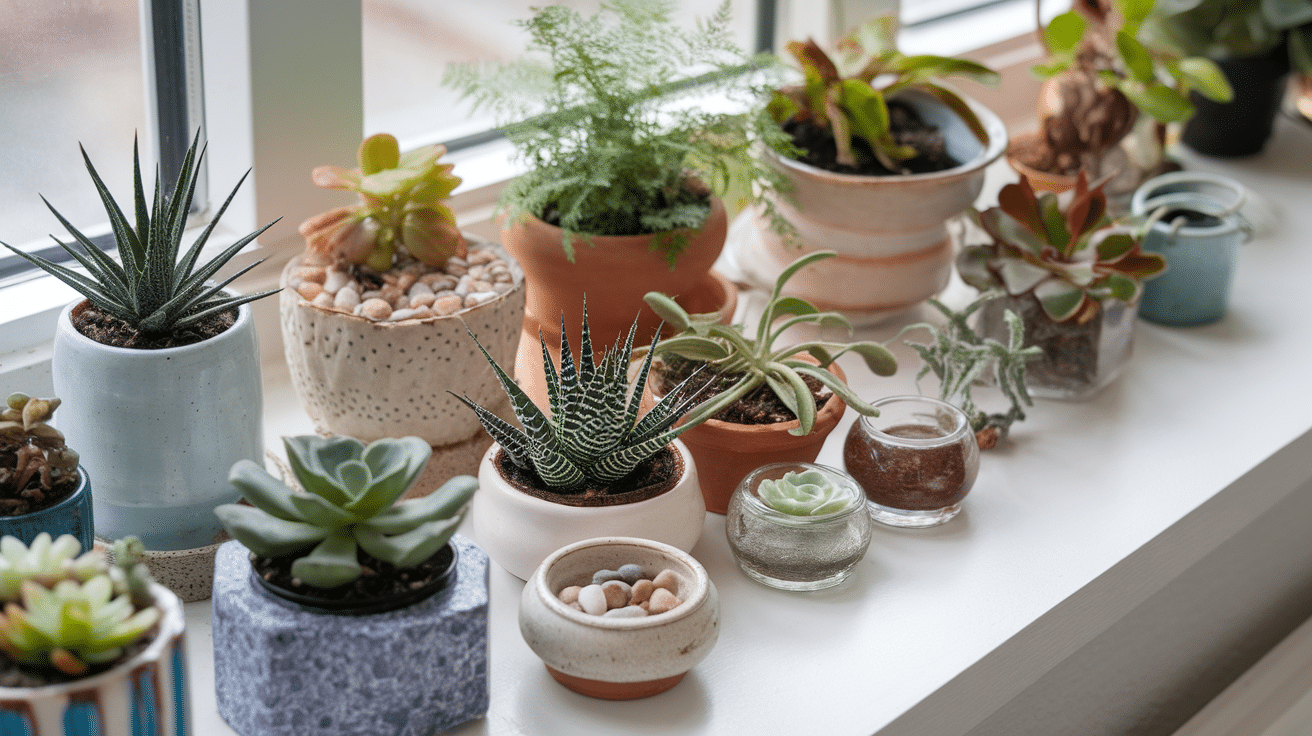
Wide window sills offer natural platforms for creative plant groupings. These spaces receive direct light and create natural focal points in rooms.
- Group plants in odd numbers (3, 5, 7) for visual appeal
- Mix plants of different heights, textures, and leaf shapes
- Use decorative stones or moss to cover soil and add visual interest
4. Glass Bottle Propagation Station
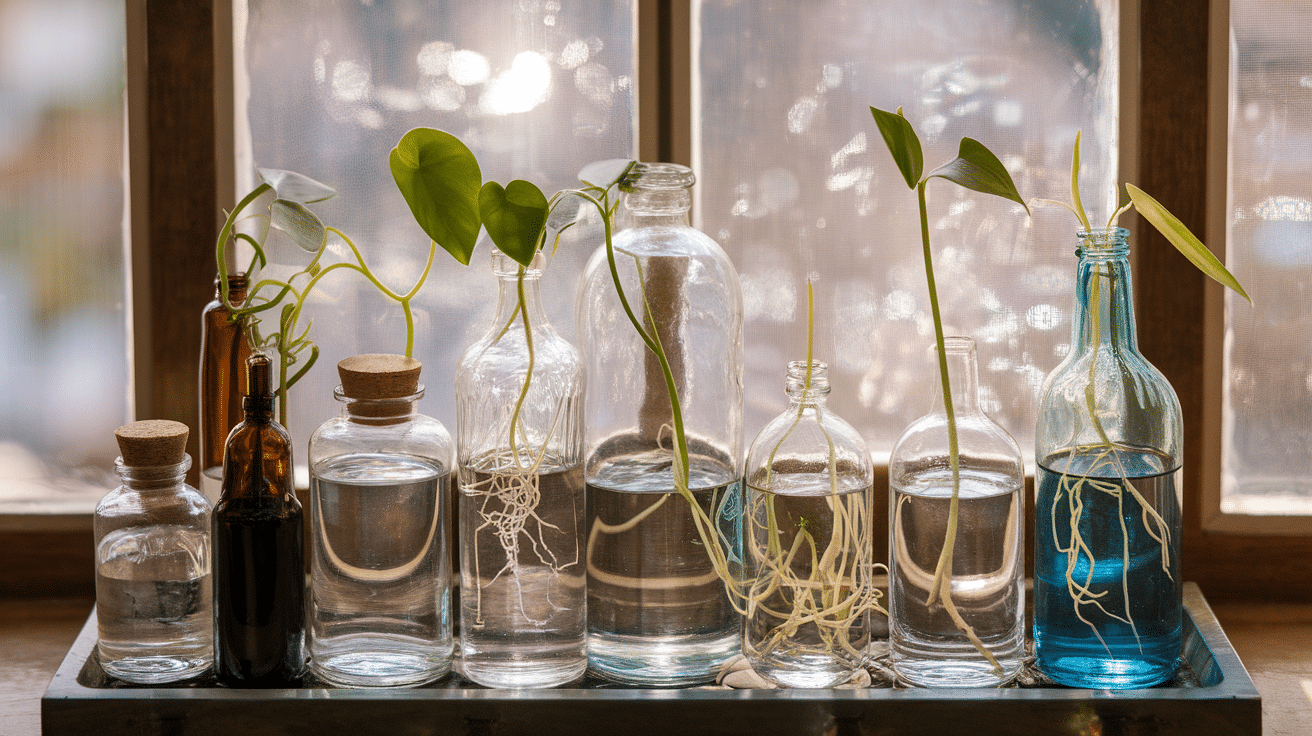
Create a dedicated station with glass containers that showcase developing roots to turn the plant propagation process into a decorative element.
- Use bottles of different heights and shapes for visual interest
- Choose colored glass that complements your decor
- Label each cutting with plant type and date started
5. Wall-Mounted Containers
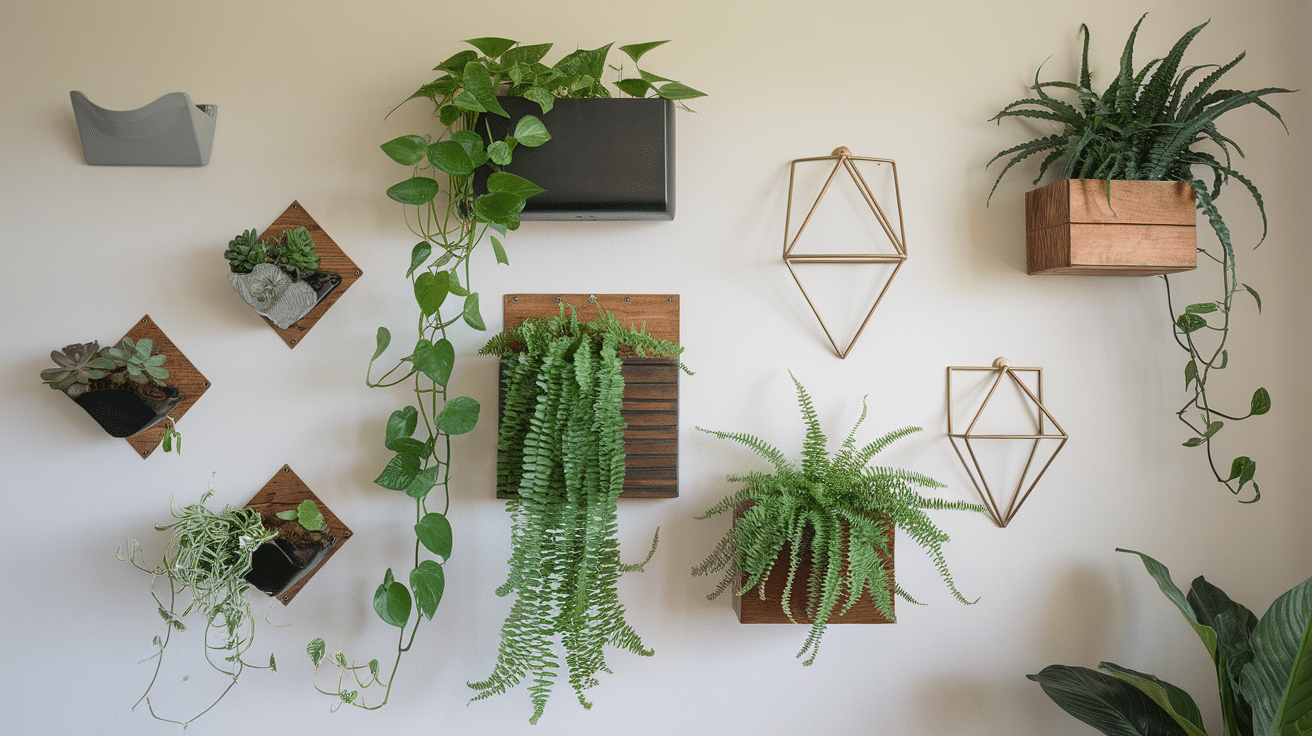
Walls offer vast unused space for growing plants in homes where floor and surface area is limited. Wall-mounted planters turn empty vertical spaces into living green canvases.
- Look for planters with built-in water catchment to prevent wall damage
- Create patterns or clusters that complement your room’s shape and size
- Mix shallow-rooted plants that thrive in limited soil space
6. Climbing Plants on Trellises
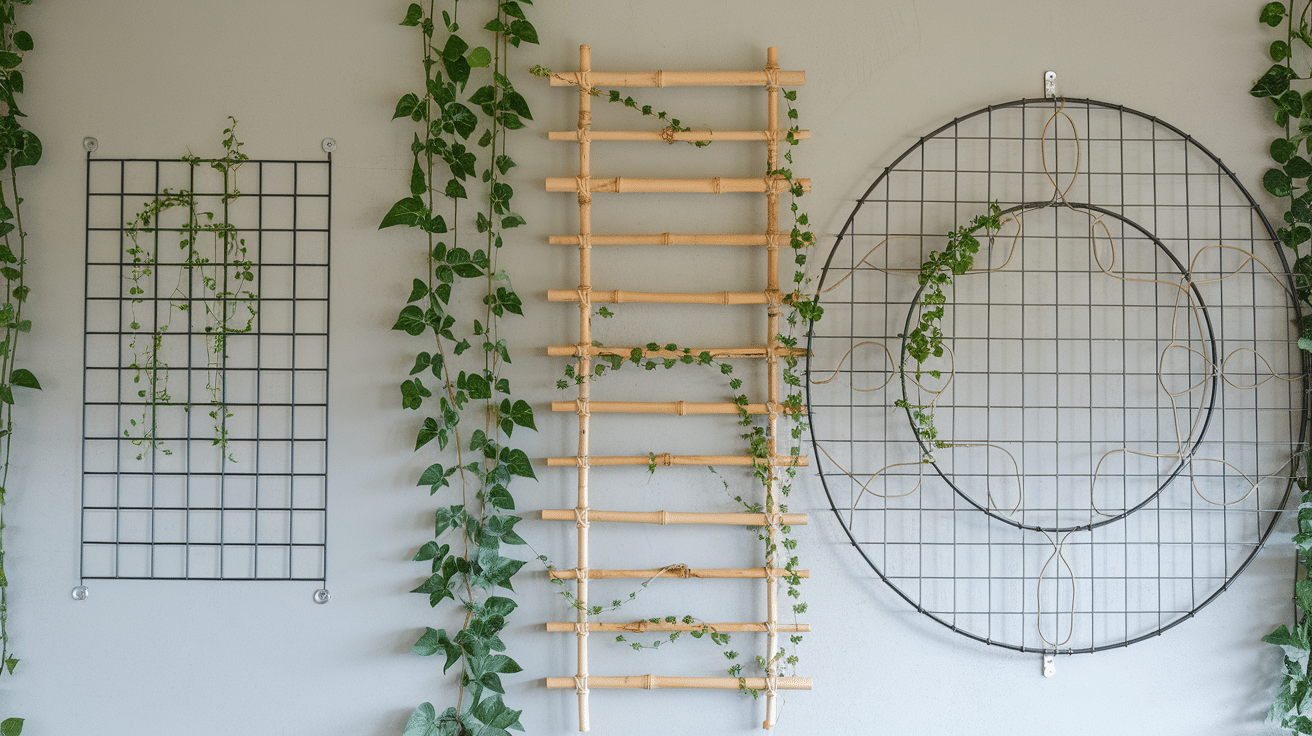
Guide climbing plants to create living wall art by training them along custom patterns. This technique works wonderfully in corners or along plain wall sections.
- Install small hooks or specialty plant clips that won’t damage walls
- Create geometric shapes with thin garden wire for plants to follow
- Choose fast-growing varieties like pothos or ivy for quicker results
7. Picture Frame Planters
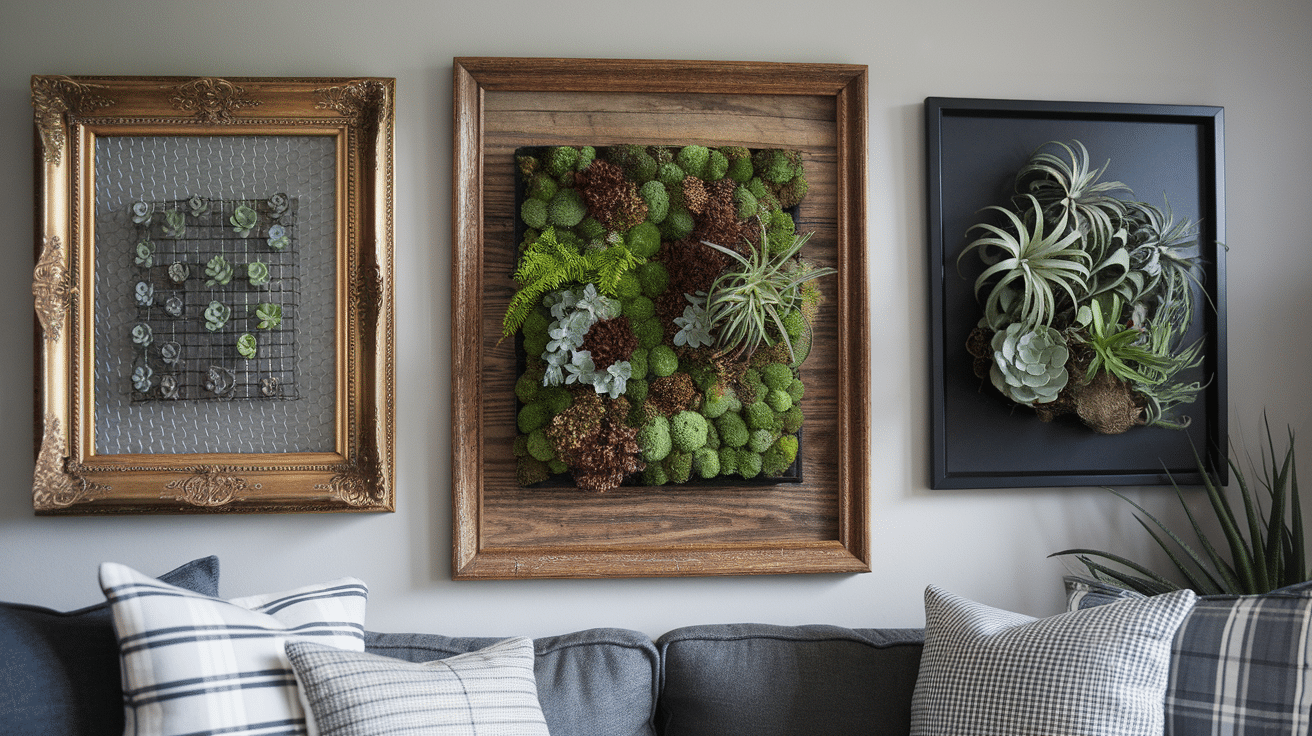
Transform ordinary picture frames into extraordinary living plant displays that combine structure and nature. These vertical gardens function as true living artwork.
- Repurpose old wooden frames from thrift stores or garage sales
- Add chicken wire backing to support soil and plants
- Use sheet moss as a base layer to prevent soil from falling through
8. Bookshelf Borders
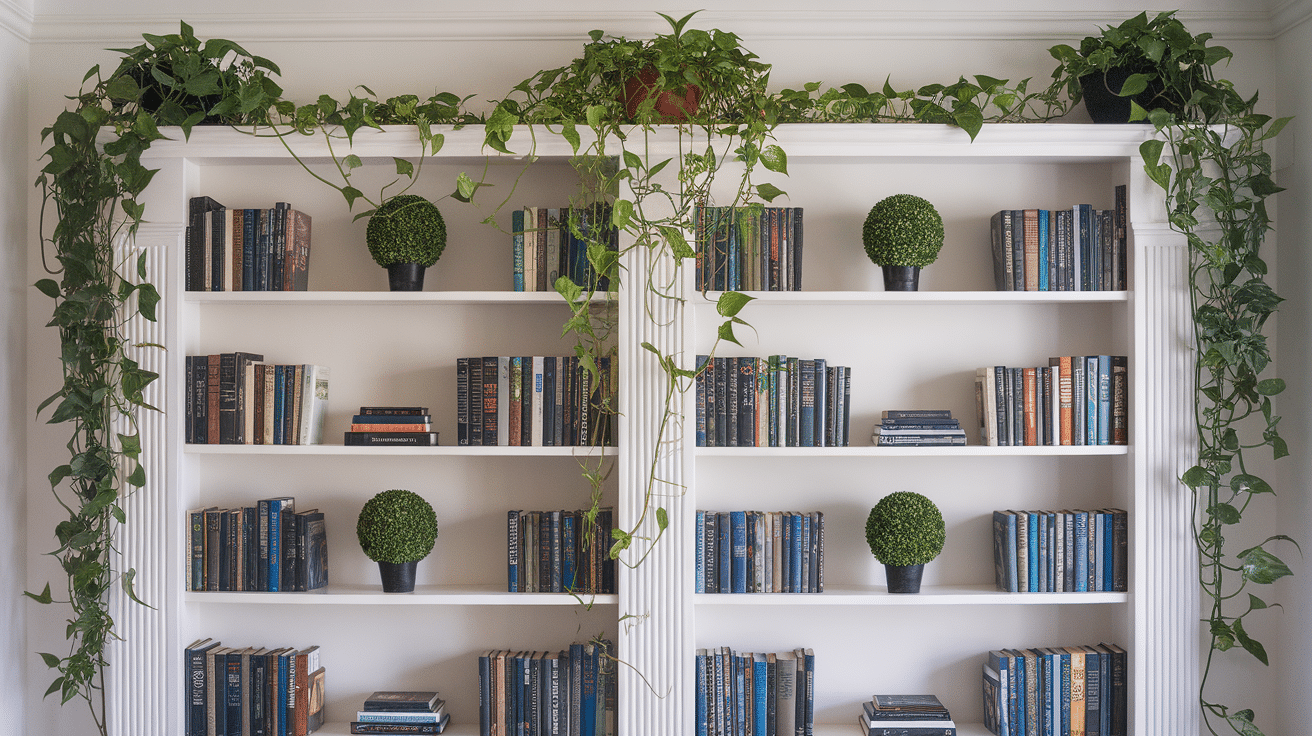
Add trailing plants along the tops or sides of bookshelves to soften their hard edges and straight lines. This method adds life to otherwise static displays.
- Position plants where trailing vines won’t obstruct book titles
- Use plants with different trailing patterns – some straight, some vining
- Place in cachepots to protect books and shelves from water damage
9. Plant Stands
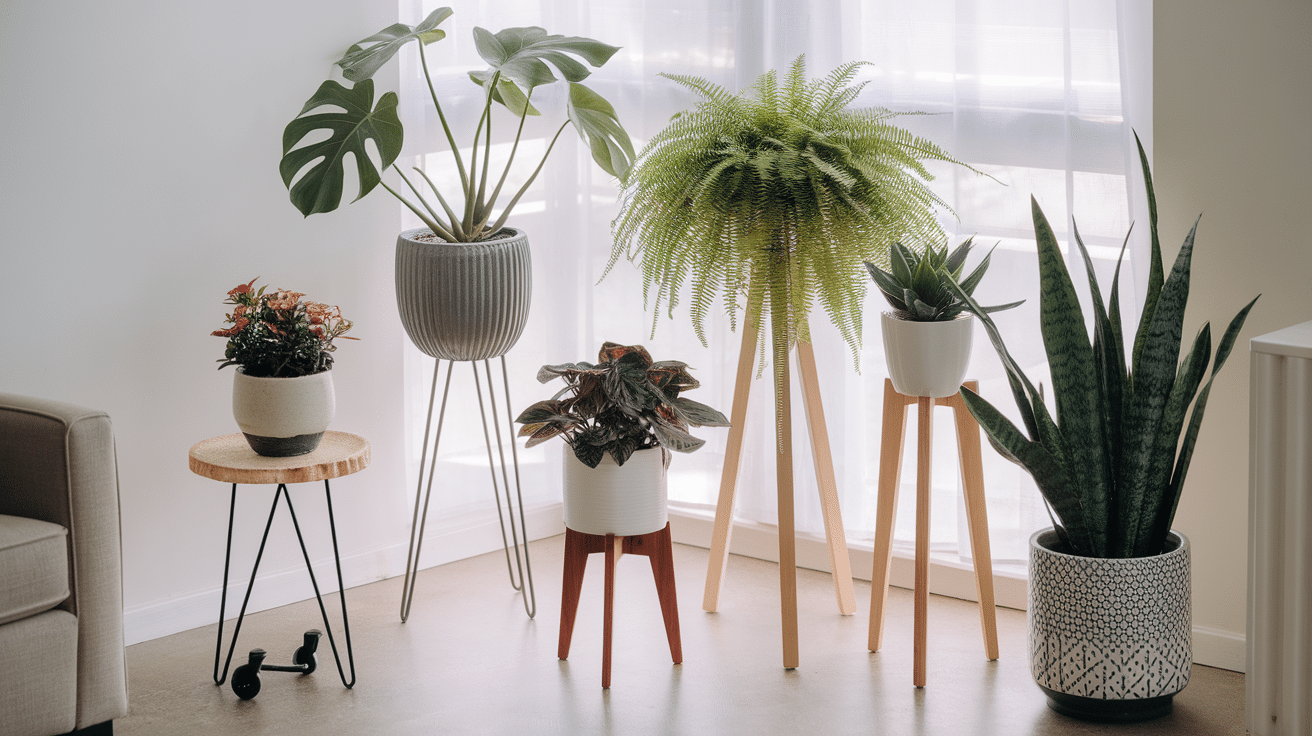
Plant stands provide functional elevation, bringing plants to eye level and creating visual layers in your décor. These versatile pieces work in nearly any room of your home.
- Mix materials like wood, metal, and ceramic for textural contrast
- Place stands of graduated heights in corner arrangements
- Use stands to elevate plants that need better air circulation
10. Table Centerpieces
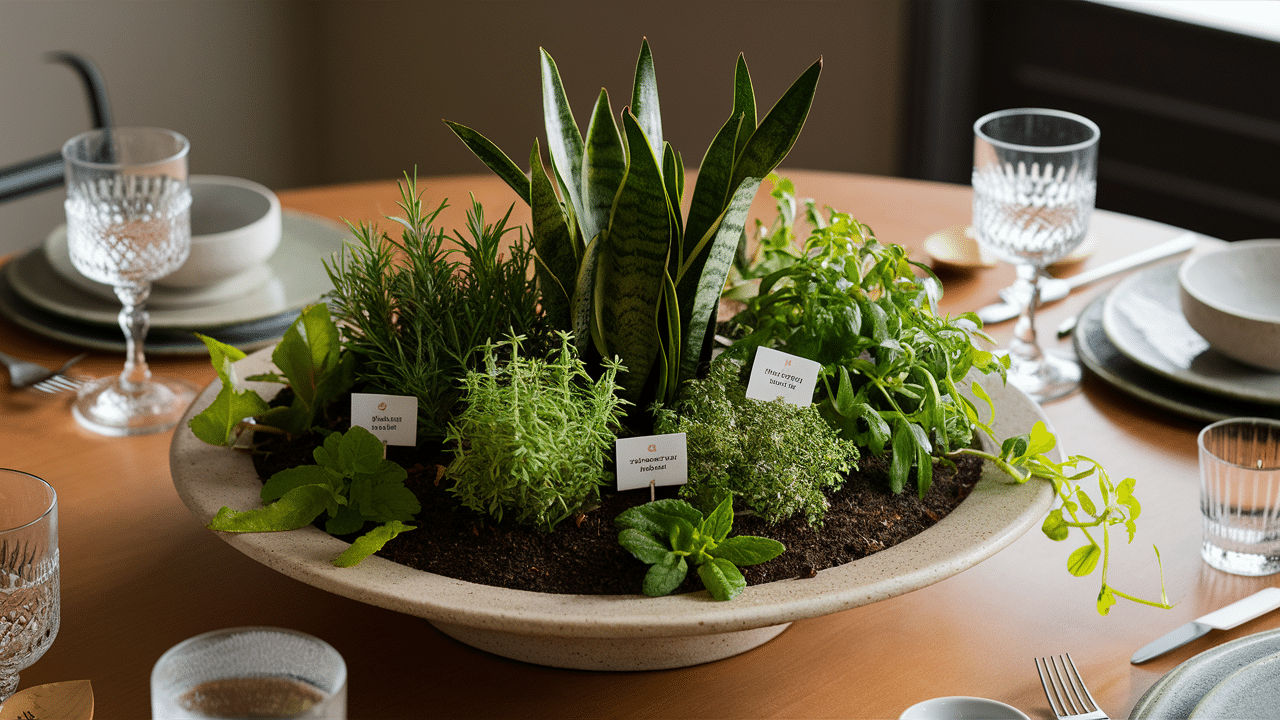
The dining table presents a perfect platform for showcasing special plants as natural art. Unlike cut flowers, potted plants provide lasting beauty that changes and grows.
- Choose low-profile plants that won’t block conversation across the table
- Use plants with interesting leaf patterns as conversation starters
- Select containers that complement your tableware and dining style
11. Desk Companions
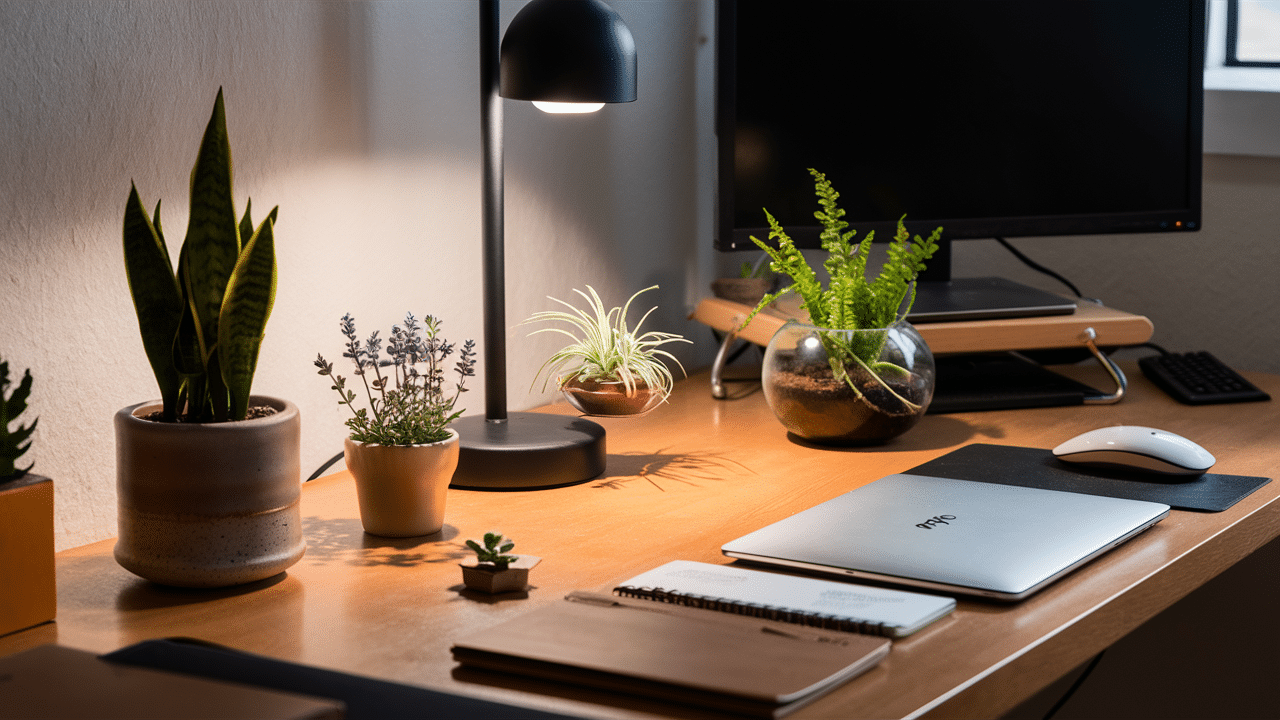
Small desktop plants provide both visual relief and air-purifying benefits in work areas. They create a connection to nature even in the most utilitarian spaces.
- Choose compact varieties that won’t take up valuable workspace
- Select plants proven to reduce stress, like lavender or snake plants
- Position plants where they won’t be knocked over during regular work
12. Coffee Table Gardens
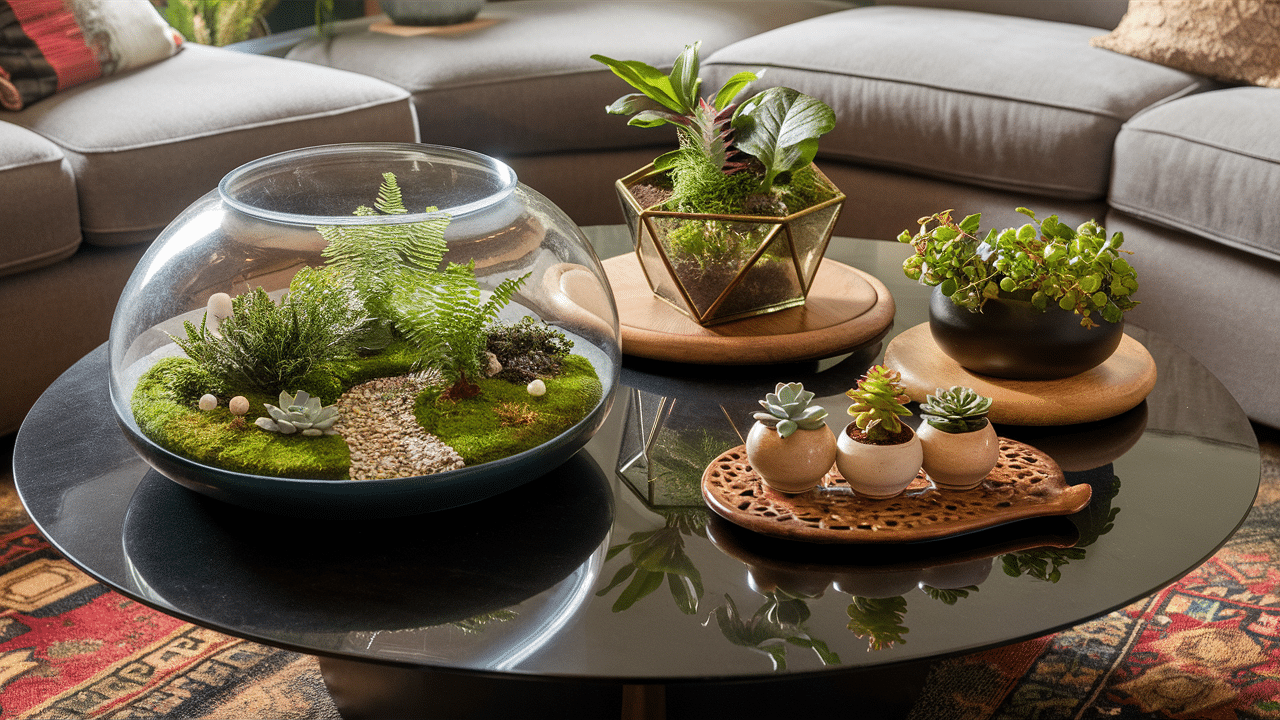
Transform your coffee table into a living display with miniature contained gardens. These small-scale landscapes become interactive art pieces in your main living space.
- Create terrariums in clear glass containers for viewing from all angles
- Design miniature landscapes complete with tiny paths or decorative stones
- Choose plants that naturally stay small or grow slowly
13. Plant Screens
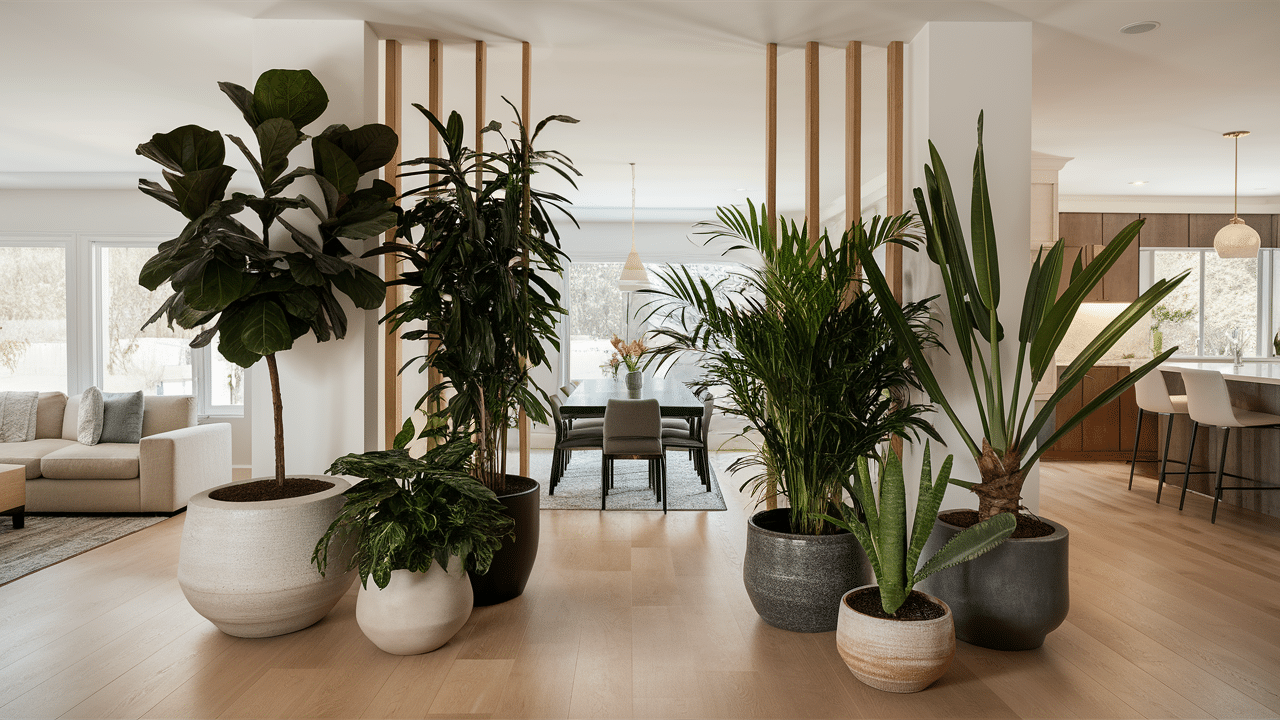
In open floor plans, strategically placed tall plants create natural living boundaries between functional areas without building walls. This soft division maintains openness while defining separate spaces.
- Use floor plants with heights between 3-6 feet for ideal division
- Select plants with fuller foliage to create more visual separation
- Arrange in a slight zigzag pattern rather than straight lines
14. Hanging Dividers
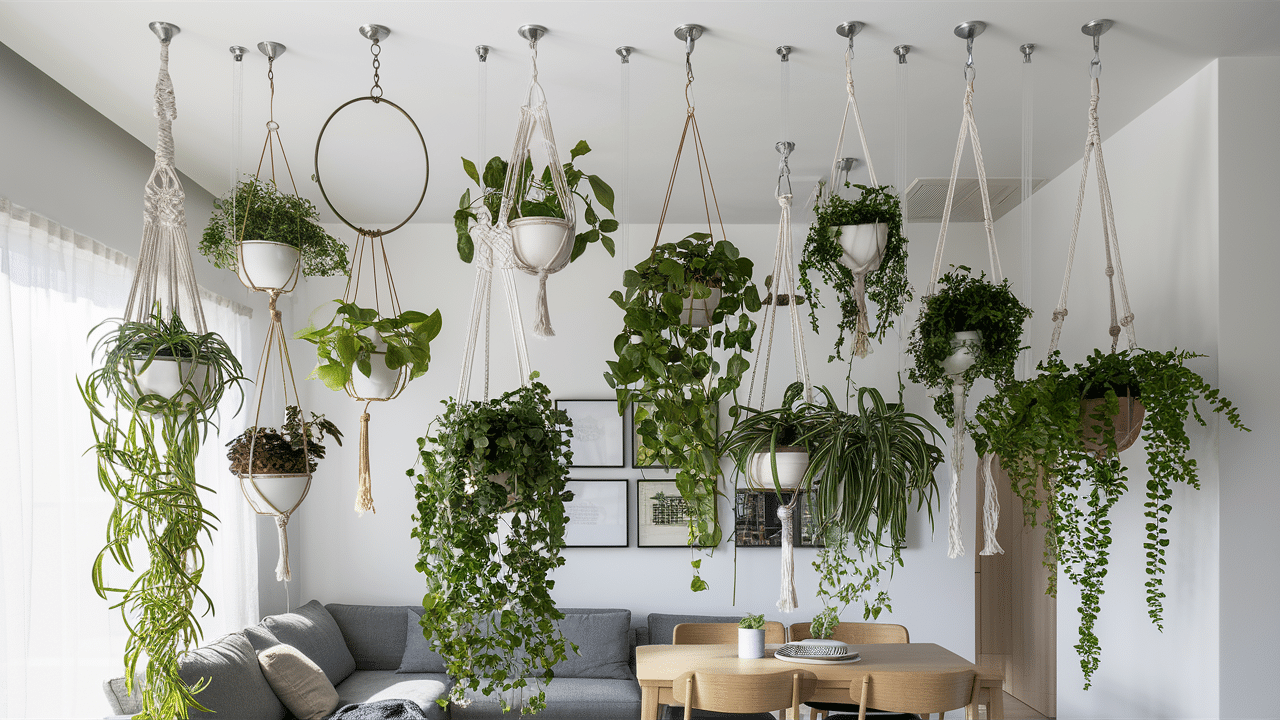
Suspended plants create ethereal, movable boundaries between spaces while keeping floor space completely open. This approach works particularly well in areas with higher ceilings.
- Install ceiling tracks that allow plants to be repositioned
- Hang plants at varying heights to create visual rhythm
- Mix plants that grow upward with those that cascade downward
15. Shelf Dividers
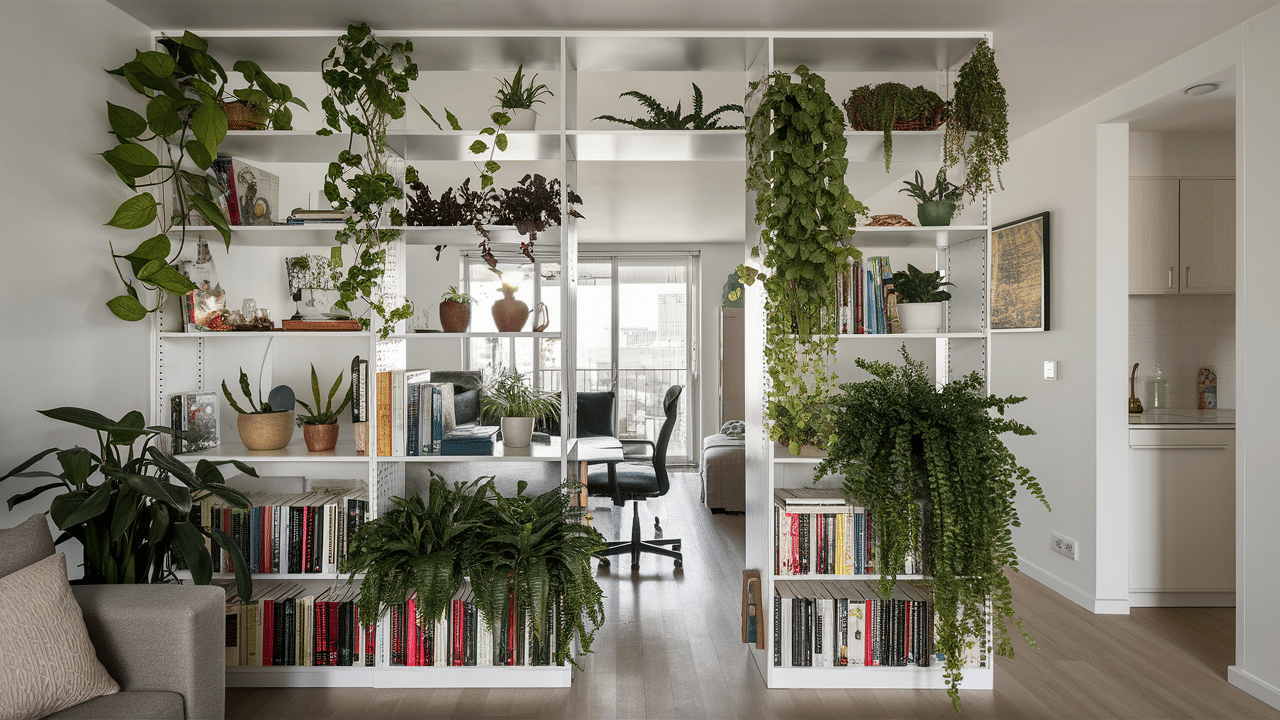
Open shelving units filled with strategically placed plants create semi-private areas while still allowing light and air to flow freely. They combine storage, display, and room division functions.
- Alternate plants with books or decorative objects for balanced displays
- Place larger plants on bottom shelves for stability and visual weight
- Use shelves with adjustable heights to accommodate growing plants
16. Rolling Plant Carts
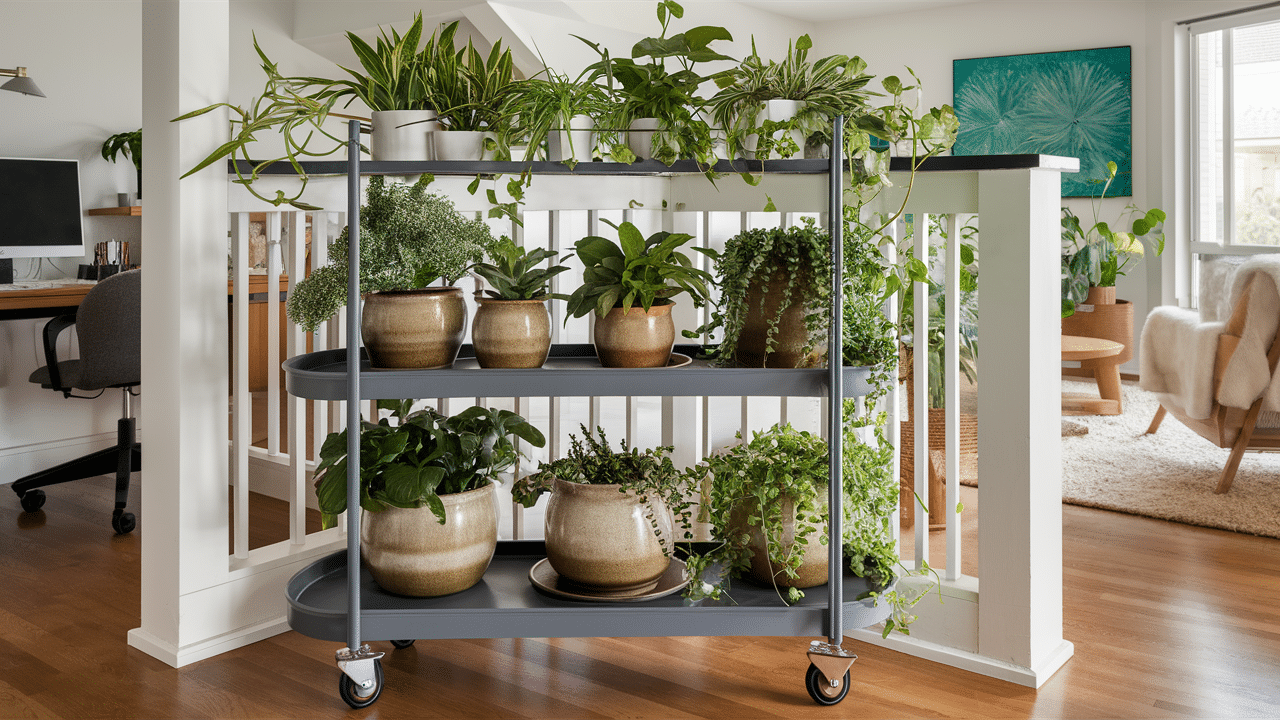
Mobile plant collections on wheeled carts or stands provide flexible, reconfigurable room division that can change as your needs do. This approach is perfect for renters or those who like to rearrange frequently.
- Choose sturdy carts with locking wheels for stability
- Load heavier plants on lower shelves to prevent tipping
- Use waterproof trays on each shelf level to protect the cart
17. Bathroom Greens
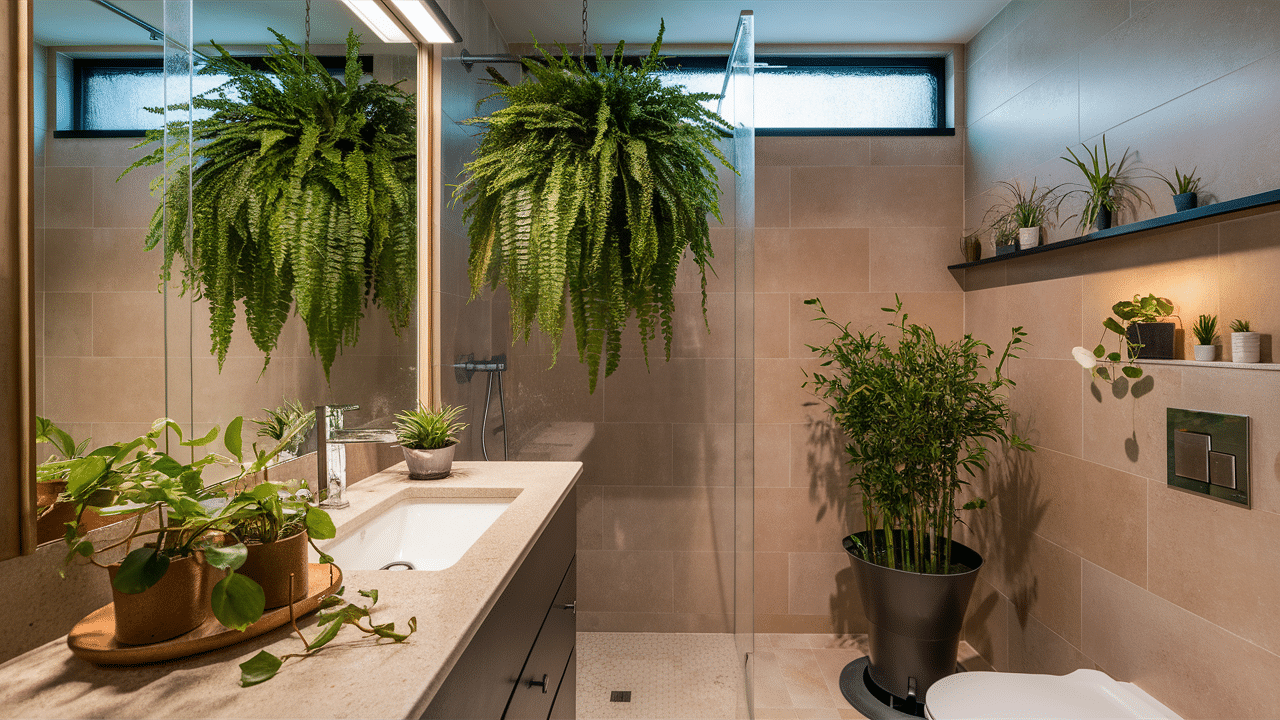
Bathrooms offer ideal growing conditions for many humidity-loving plants, yet they’re often overlooked as plant locations. The steam from showers creates a mini tropical environment that certain plants thrive in.
- Choose plants like ferns, peace lilies, and pothos that love humidity
- Place plants away from direct water splashes but near shower steam
- Use wall-mounted containers to save limited counter space
18. Kitchen Herbs
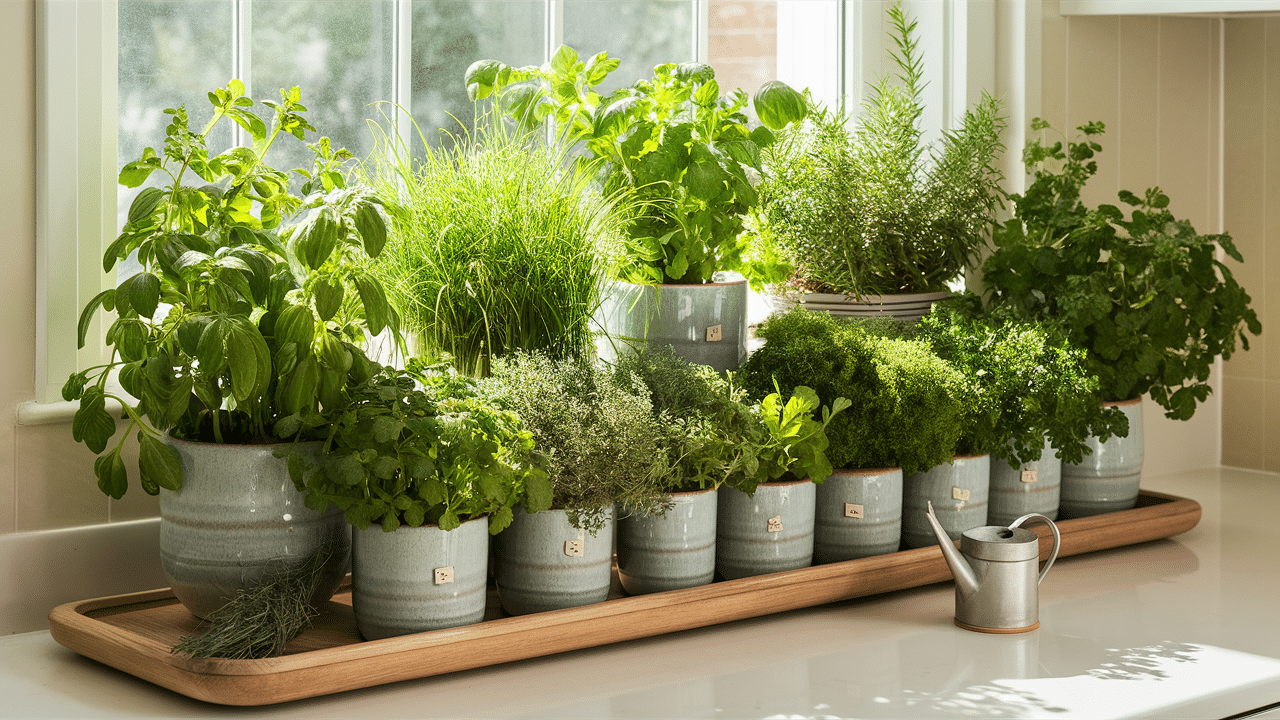
Bringing herbs into your kitchen combines beauty with function. Plants are placed exactly where you’ll use them. Fresh herbs improve your cooking while adding life to work surfaces.
- Group herbs in matching containers for a cohesive look
- Plant according to usage frequency, with most-used herbs in easy reach
- Choose varieties that thrive indoors, like basil, chives, and mint
19. Staircase Borders

Staircases offer a unique opportunity to create a graduated plant display that guides the eye upward. This often-overlooked space can become a stunning green focal point.
- Ensure plants don’t interfere with handrails or create tripping hazards
- Use secured containers that won’t tip if accidentally bumped
- Create a progression of plants, changing varieties as the stairs ascent
20. Under-Stair Gardens
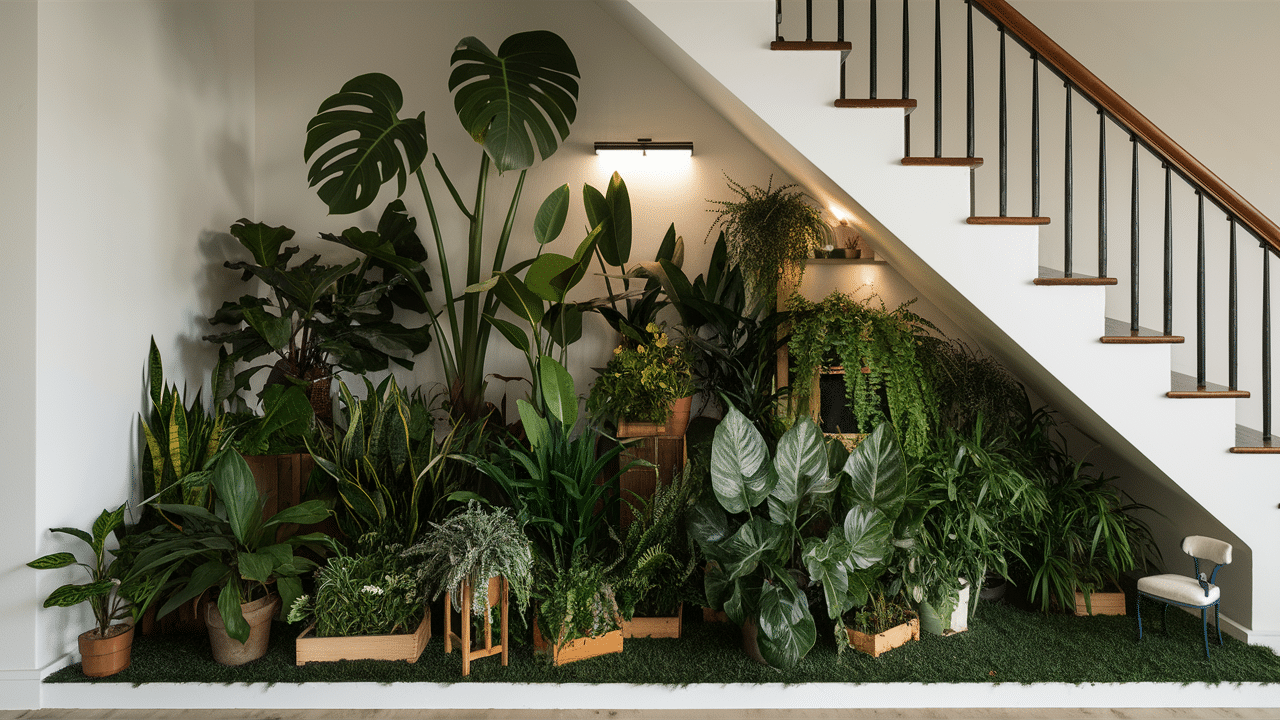
The awkward space under the stairs presents a perfect opportunity for creating lush plant corners. This often wasted area can become a mini indoor garden that maximizes every inch of your home.
- Measure the available height at different points to select appropriately sized plants
- Add small grow lights in darker under-stair areas if natural light is limited
- Create tiers using crates or small shelves to display multiple plants
21. Glass Containers
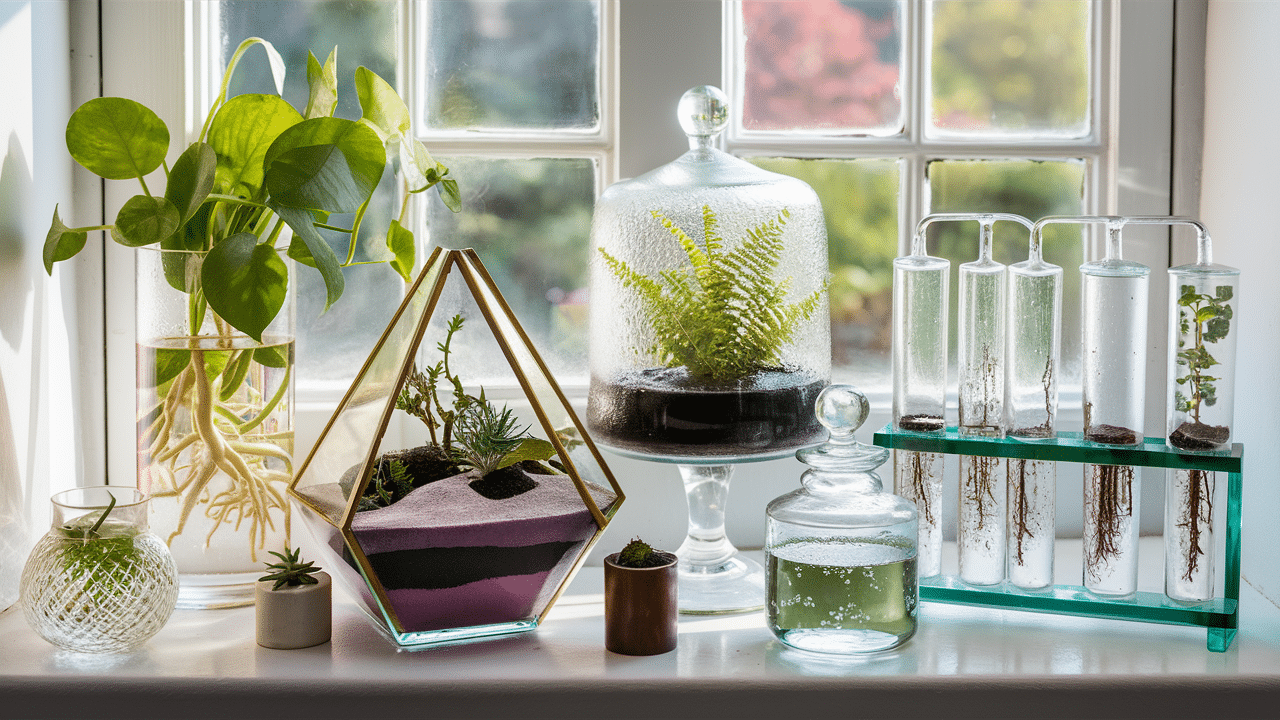
Transparent containers reveal the usually hidden parts of plants, turning roots, soil layers, and plant structure into visible art. This approach celebrates the complete beauty of plants from top to bottom.
- Use tall cylindrical vases for water-propagated plants with visible roots
- Layer colored sands in clear containers for desert plant displays
- Choose containers with interesting shapes to complement plant forms
22. Old Furniture as Planters
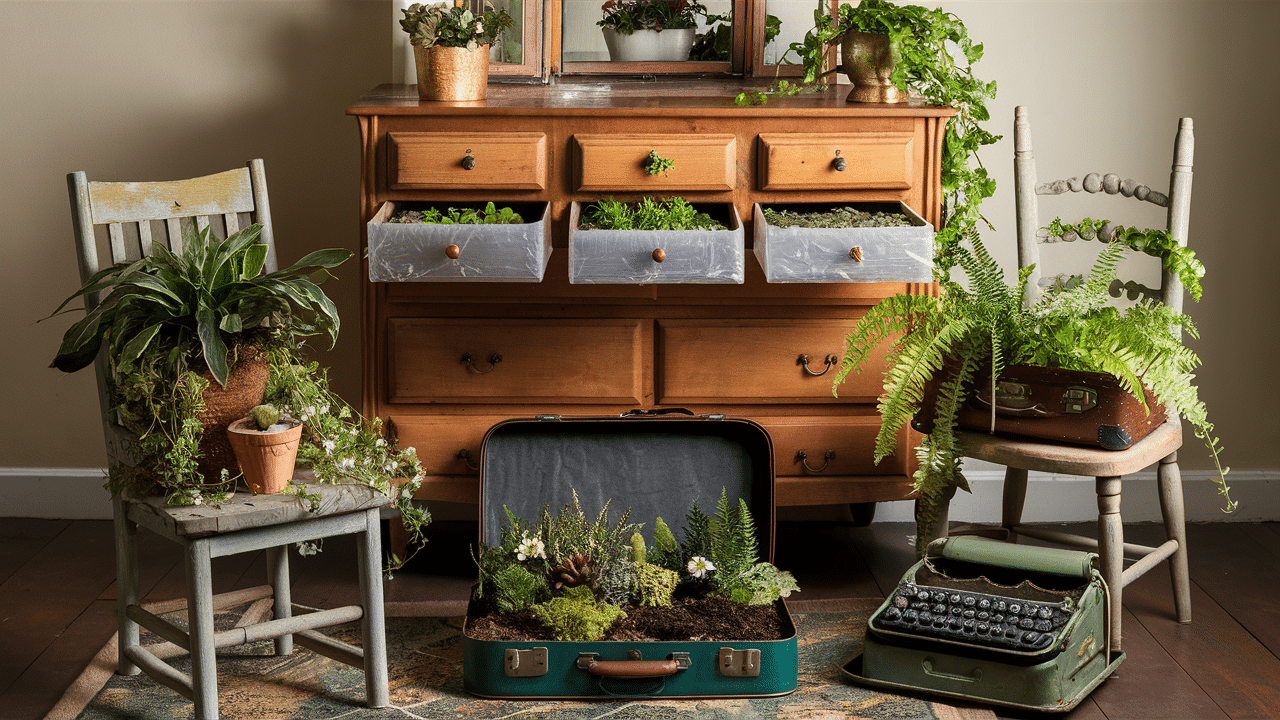
Repurposing vintage furniture pieces as plant containers adds character, history, and uniqueness to your plant displays. This approach combines upcycling with plant decor for truly one-of-a-kind arrangements.
- Line old wooden drawers with plastic before adding soil to prevent rot
- Turn unused chairs into plant stands by placing pots on seats
- Repurpose vintage suitcases as planting beds for shallow-rooted plants
23. Hanging Bottles
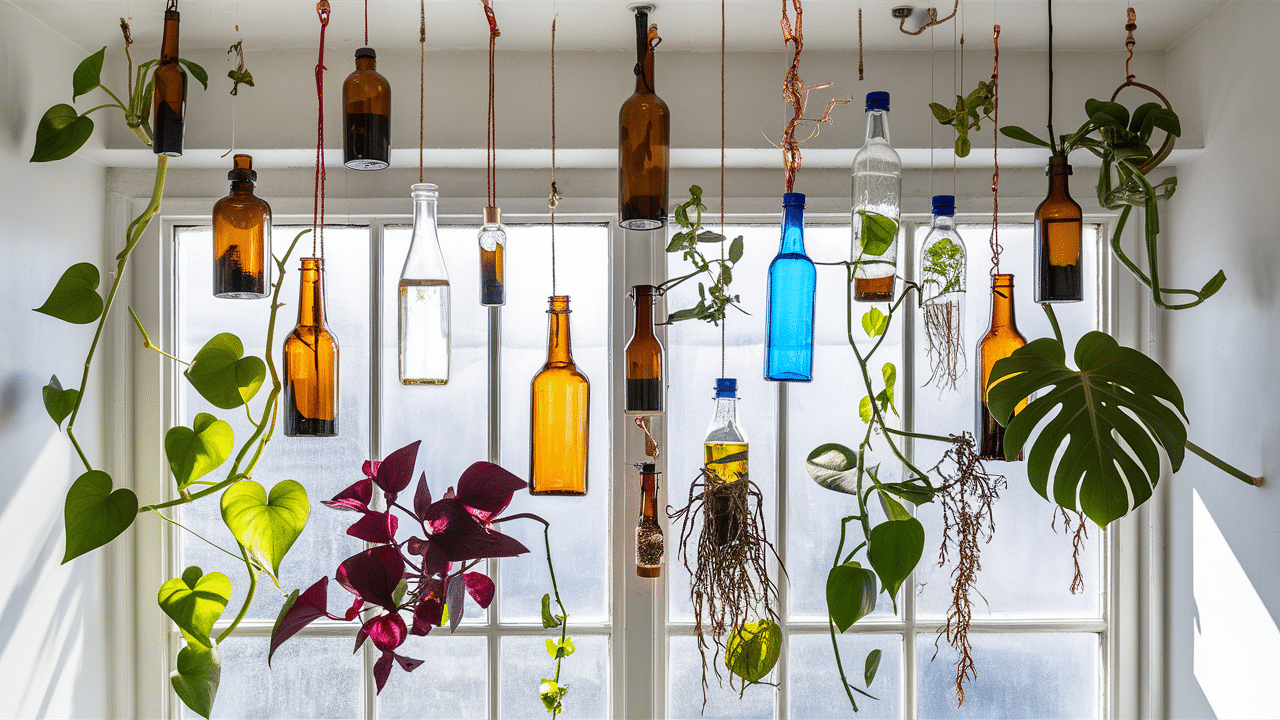
Suspended bottles create vertical interest while showcasing water-rooted plants or fresh cuttings. This budget-friendly approach turns simple glass containers into floating plant displays.
- Collect bottles with interesting shapes, sizes, and colors
- Use strong fishing line or decorative cord for hanging
- Create patterns or clusters with multiple hanging bottles
24. Teacup Gardens
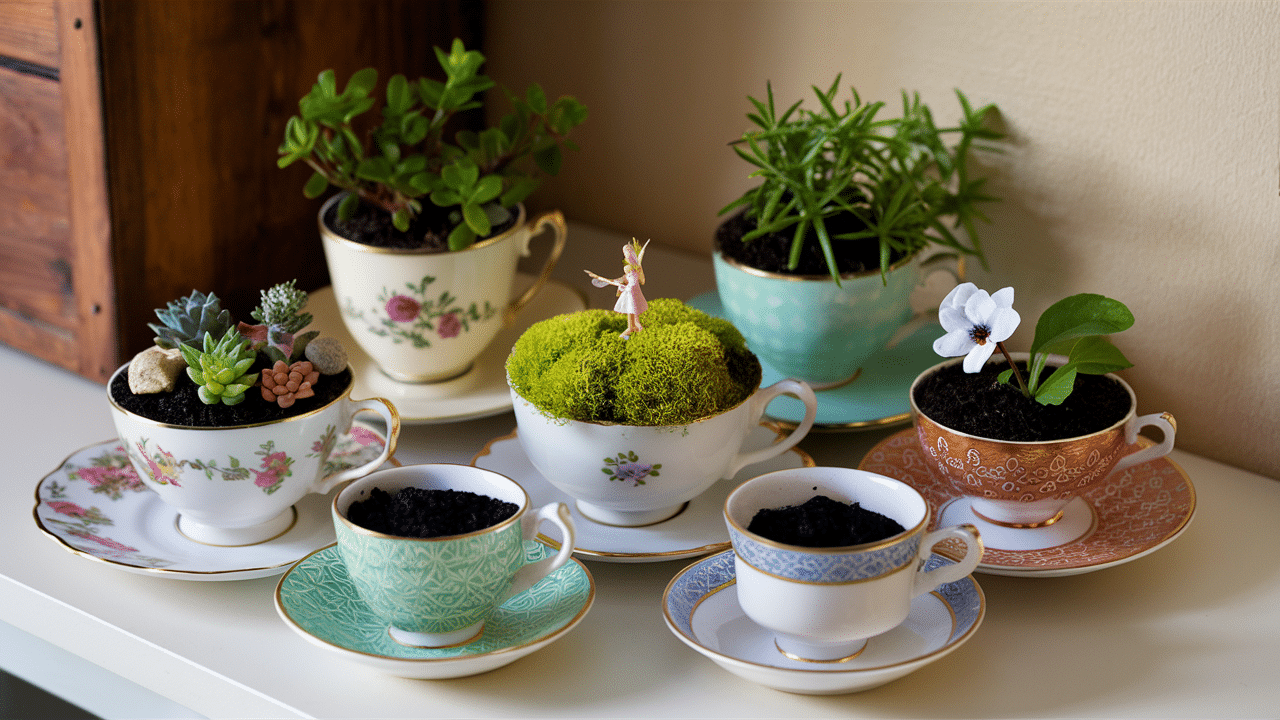
Tiny plant arrangements in teacups bring charm and whimsy to small spaces. These miniature gardens add personality to desks, shelves, and bedside tables where space is limited.
- Drill drainage holes in cup bottoms or use activated charcoal layers for drainage
- Create fairy garden themes with tiny accessories and figurines
- Use teacups with saucers to catch excess water
25. Holiday Plant Grouping
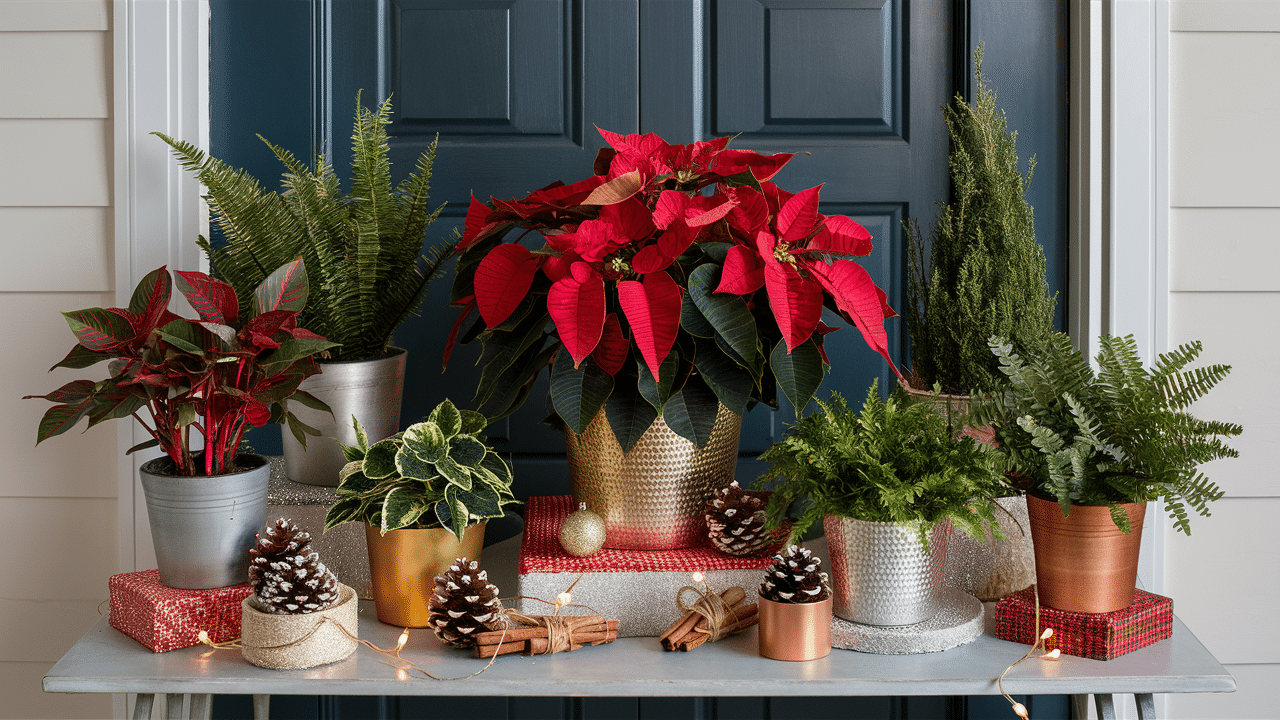
Create special plant arrangements that celebrate the changing seasons and holidays throughout the year. These temporary displays bring festive energy to your home without using disposable decorations.
- Group plants with red and green foliage for winter holiday themes
- Add white flowering plants to create snow-like effects in winter
- Use pastel-colored planters for spring holiday celebrations
26. Spring Bulb Displays
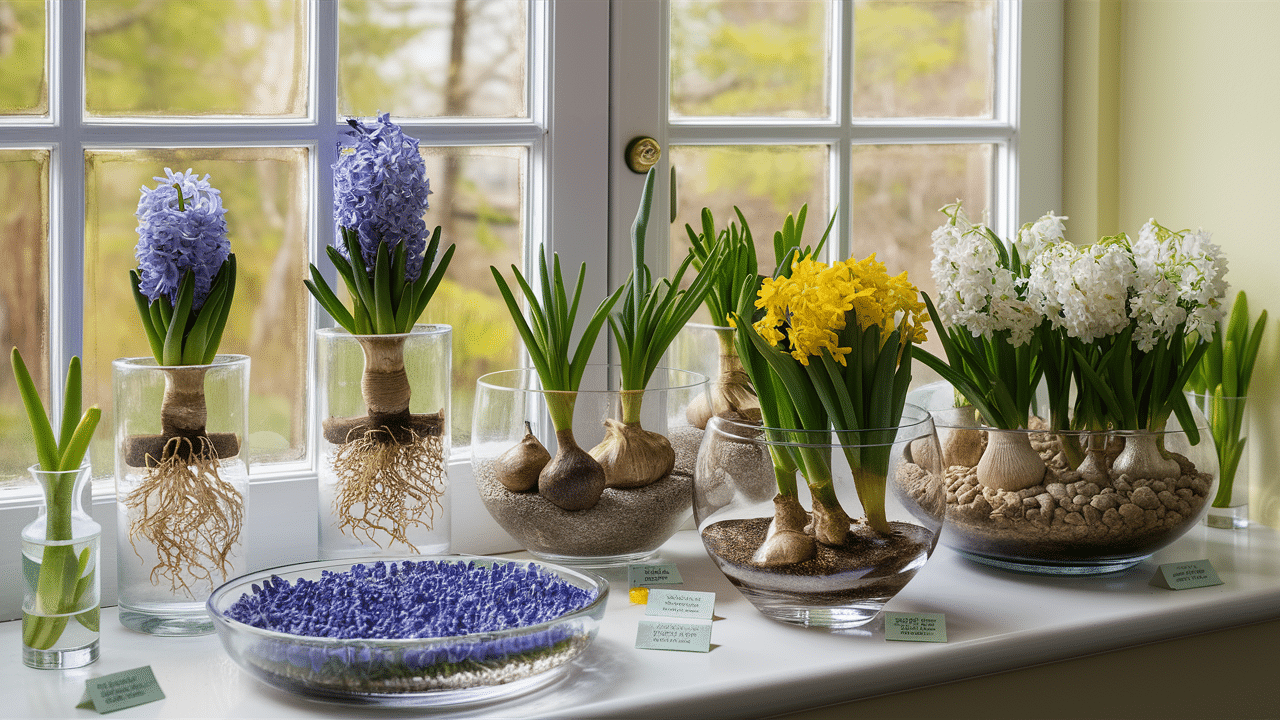
Force bulbs to bloom early to bring the joy of spring indoors. These displays provide welcome color during the final weeks of winter, when we’re most craving fresh flowers.
- Layer bulbs in clear glass containers to watch roots and shoots develop
- Stagger planting dates for continuous blooms over several weeks
- Mix bulb varieties like tulips, daffodils, and hyacinths for color variety
27. Summer Porch Plants
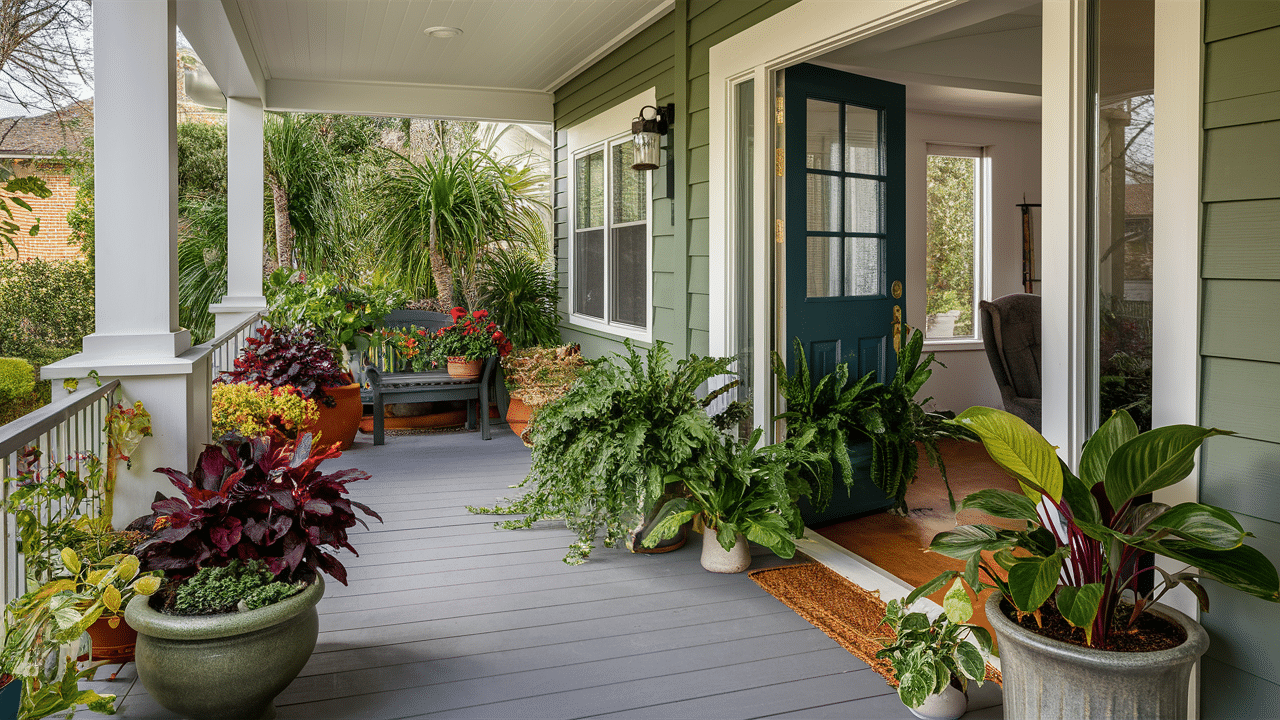
Plant arrangements that work in both environments create a seamless transition between indoor and outdoor living spaces. This approach extends your living area and brings summer abundance to threshold spaces.
- Select plants that tolerate both indoor and outdoor conditions
- Use weather-resistant containers that look good in both settings
- Create gradual transitions with more delicate plants inside, tougher varieties outsids
28. Fall Color Groups
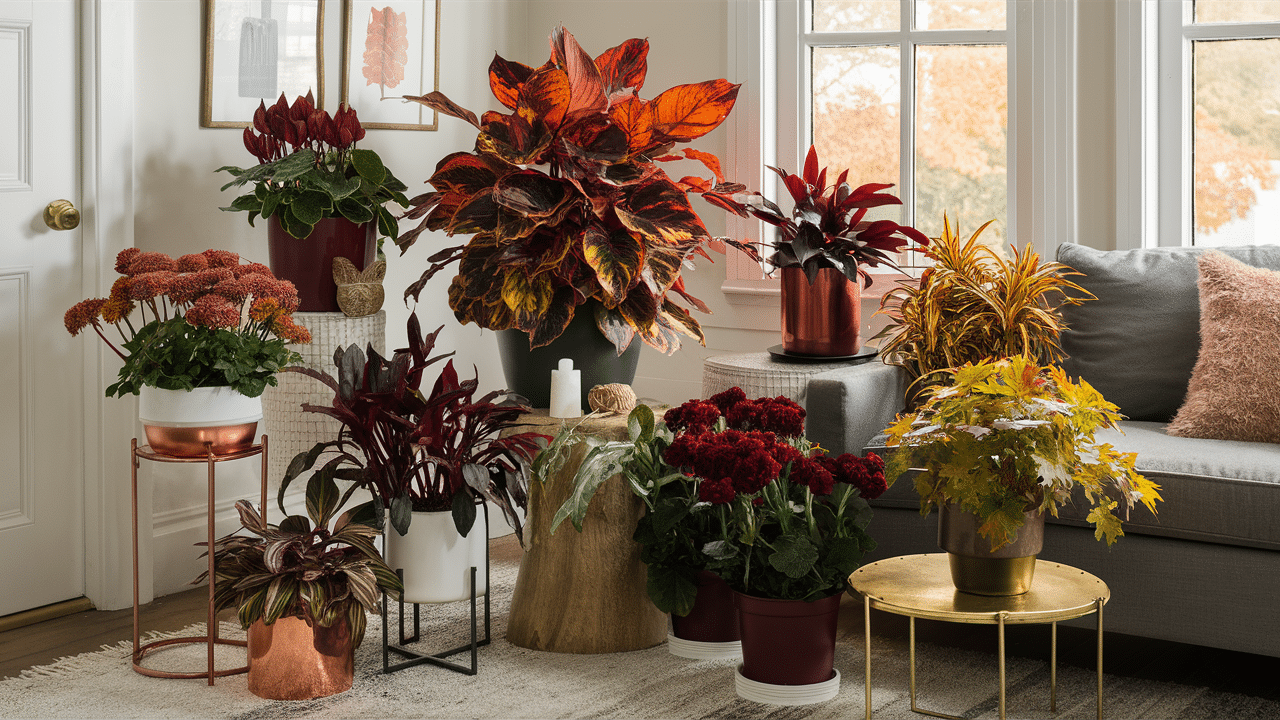
Celebrate autumn’s rich palette by featuring plants with warm-toned foliage. These arrangements complement traditional fall decor while keeping your space feeling alive and fresh.
- Include plants with naturally red, orange, or yellow foliage
- Use containers in warm metallic tones like copper or brass
- Add preserved natural elements like pinecones or dried seed heads
29. Magnetic Planters
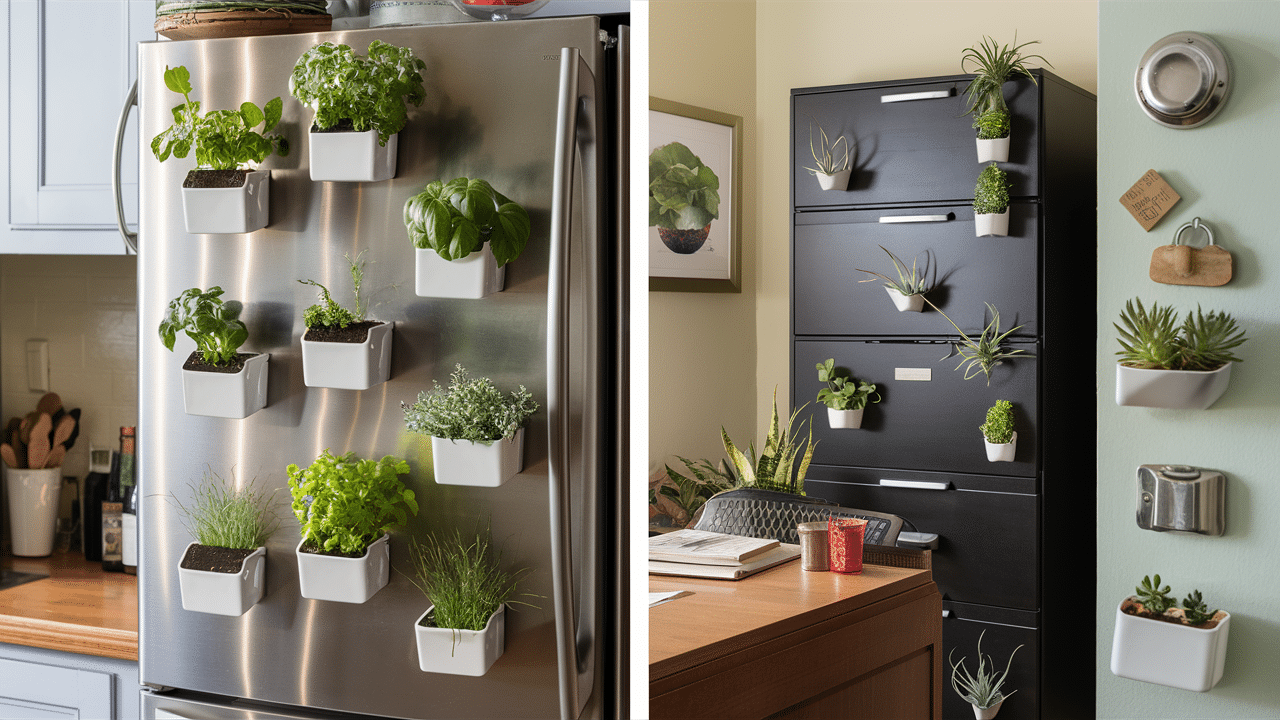
Magnetic planters unlock vertical growing space on metal surfaces that would otherwise go unused. These clever containers are perfect for small homes where every inch counts.
- Attach to refrigerators for handy kitchen herb gardens
- Use on metal filing cabinets in home offices for desk plants without using desk space
- Look for magnetic planters with drainage systems to prevent water damage
30. Hanging Macramé Holders
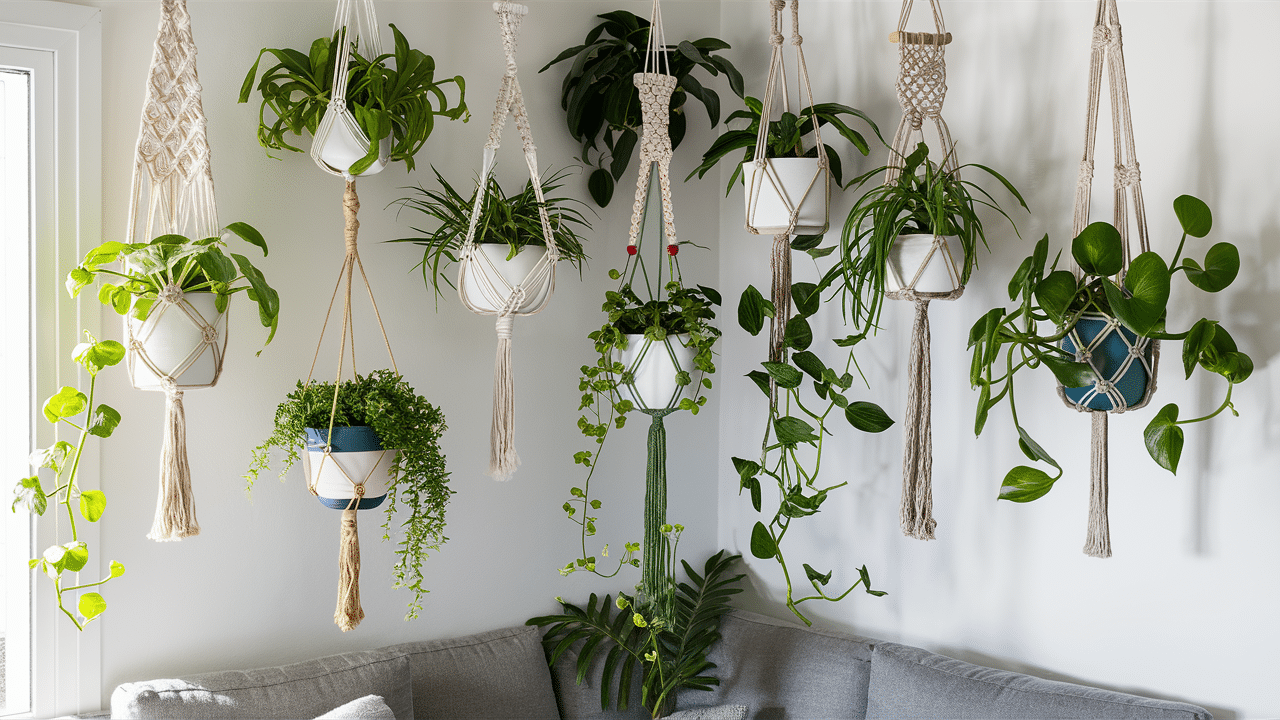
Suspended plant holders free up valuable floor and surface space by utilizing the area above. These hanging gardens bring plants to eye level while keeping pathways clear.
- Vary cord lengths to create multi-level hanging gardens
- Choose holders with different patterns for visual interest
- Select plants with trailing habits that will grow downward
31. Door Frame Accents
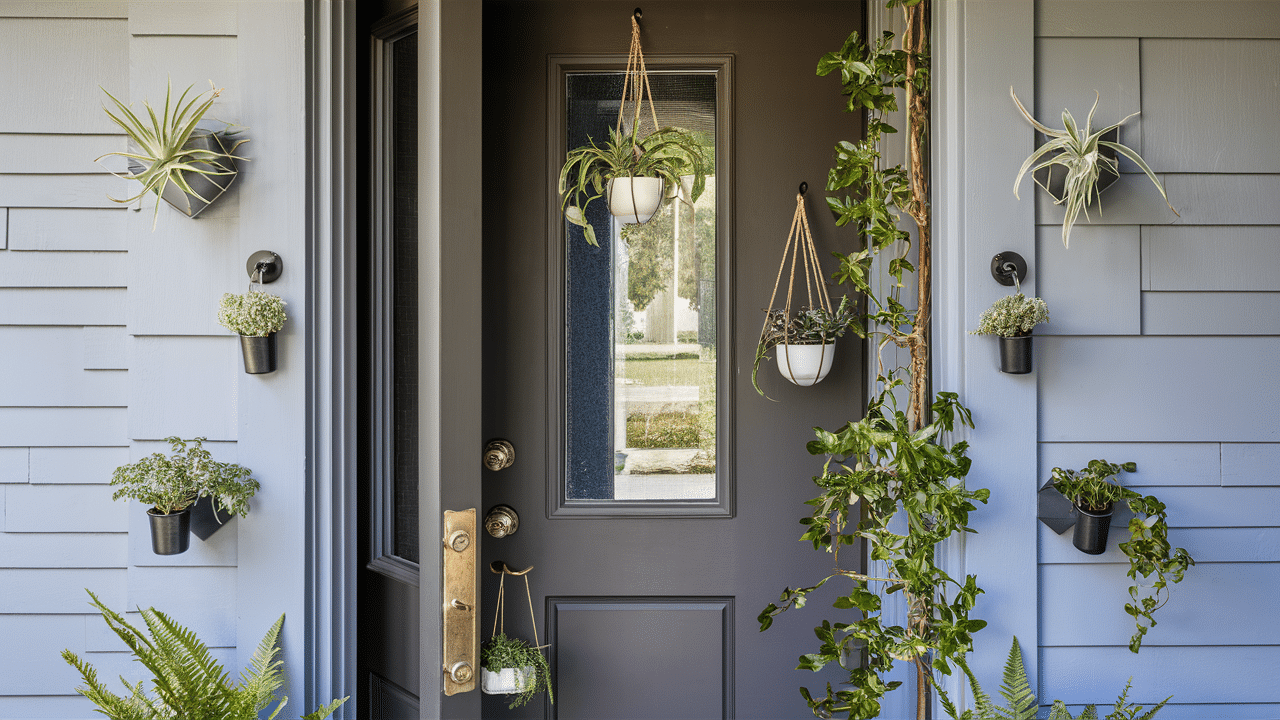
The often-overlooked space around door frames offers perfect spots for small plant accents. These unexpected touches add life to transitional spaces without interfering with function.
- Hang lightweight air plants or small potted plants on discreet hooks
- Position plants high enough to clear head height for safety
- Use brackets that extend plants away from the walking path
32. Corner Clusters
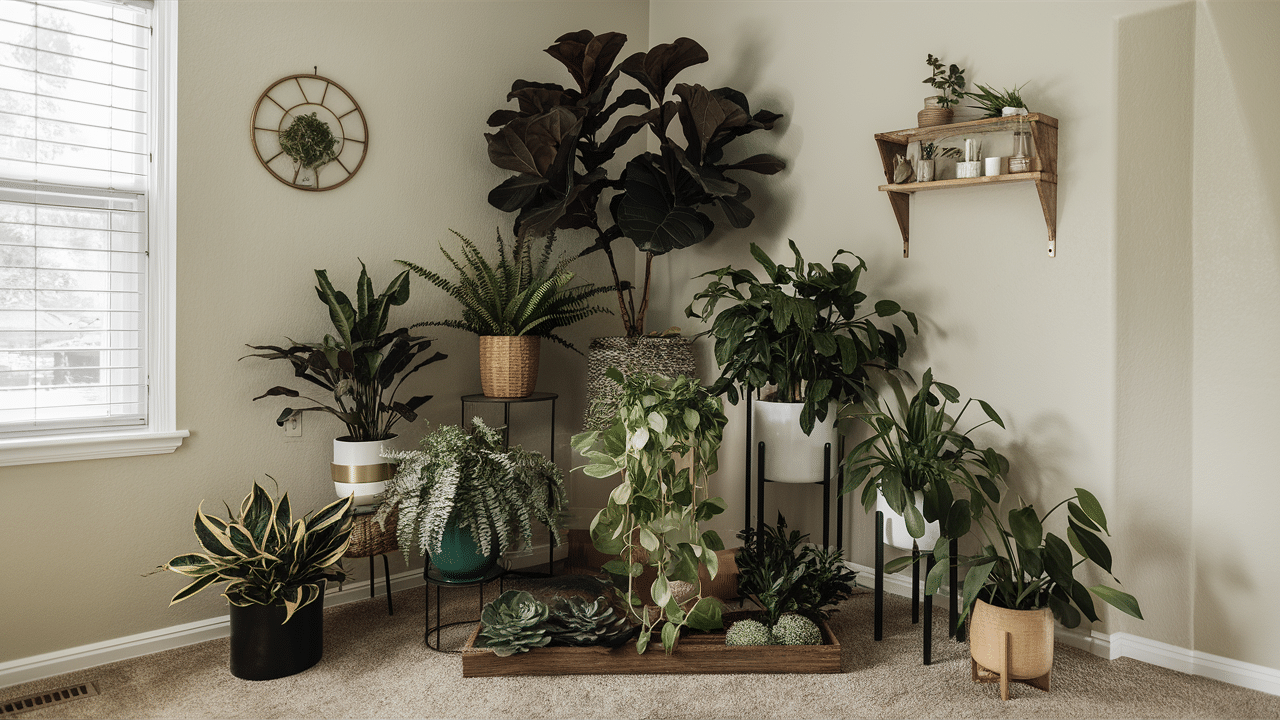
Empty corners in rooms can be transformed from awkward dead spaces into stunning plant displays. Corner arrangements maximize otherwise wasted areas while adding three-dimensional interest.
- Use plants of varying heights to create a natural pyramid shape
- Position the largest plants at the back corner, with smaller ones radiating forward
- Add a corner shelf unit specifically designed for plants
Why Use Plants in Home Decor?
Before we get into the how-to, let’s talk about why adding plants to your home makes sense:
- Save money: plants are often cheaper than other decor items
- Update your look: change the style without major remodeling
- Improve air quality: Many plants help clean indoor air
- Boost your mood: Studies show plants reduce stress
- Create interest: Living items bring movement and change to spaces
I added plants to my home last year when i wanted to update the look but couldn’t afford new furniture. The total cost was under $100, and my house still looks great today.
Common Mistakes and How to Avoid Them
Let Me Save You from The Mistakes I Made on My First Try:
Plants Dying Too Quickly
- Cause: Choosing the wrong plants for your light conditions
- Fix: Match plants to the actual light in your home, not what you wish you had
Messy Water Damage
- Cause: No saucers or protection under pots
- Fix: Always use saucers, trays, or pot covers to catch water
Crowded, Cluttered Look
- Cause: too many small plants scattered everywhere
- Fix: Group plants together in odd numbers (3, 5, 7) for a more planned look
Plants that Look out Of Place
- Cause: not considering the style of your home
- Fix: Choose plants and containers that match your existing style
Constant Maintenance Issues
- Cause: Choosing high-maintenance plants
- Fix: Start with hardy varieties like snake plants, pothos, or zz plants
Taking your time with each step will help you avoid most of these issues. Remember that rushing usually leads to dead plants and wasted money.
Finishing Touches and Care Tips
After setting up your plant displays, you’re ready for the final steps that complete your home transformation.
1. Add Complementary Elements
Consider adding small lights among plants for an evening ambiance. Small mirrors behind plants can make arrangements look fuller and reflect light onto plants.
Natural elements like pretty rocks, wood pieces, or shells can enhance plant displays and create a cohesive natural theme.
2. Create Care Routines
Set a specific day for plant checks and watering rather than trying to remember each plant’s schedule separately.
Group plants with similar water needs together to streamline care. This prevents both overwatering and underwatering.
3. Fix Minor Issues Quickly
Even with careful planning, you might discover minor problems once everything is set up.
Plants that start to stretch toward light sources should be rotated regularly to maintain their shape. If a plant isn’t thriving in one spot, don’t hesitate to move it elsewhere.
Conclusion
Decorating with plants is a simple way to update your home without spending much money. By following these ideas and taking your time, you can create a green space that looks put-together and feels welcoming.
The Key Points to Remember:
- Match plants to your actual light conditions
- Group plants for impact rather than scattering them
- Choose containers that complement your style
This weekend project can save you hundreds compared to buying expensive decor items. Plus, you’ll feel satisfied nurturing living things!
Now that you know how to do it, what’s stopping you? Those empty corners and shelves could be green and lively by the end of the weekend.
Have you decorated with plants before? Did you try a specific arrangement that worked well? Share your experience in the comments below! I’d love to see how your green home turned out.

